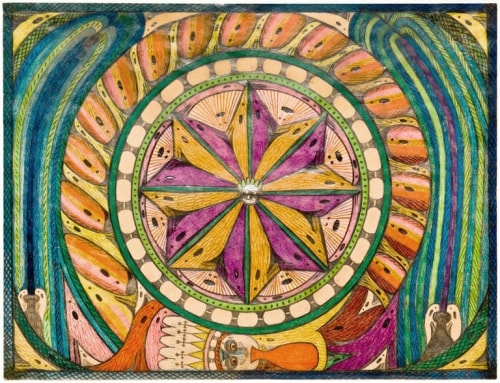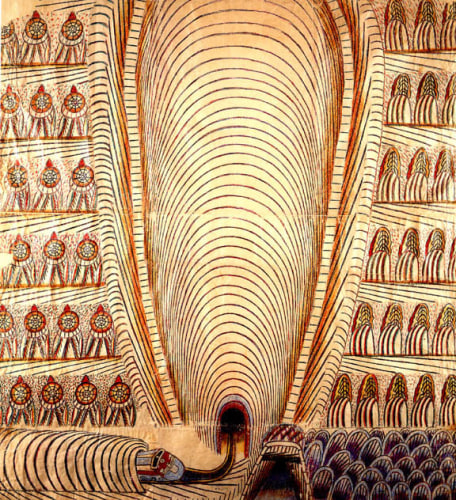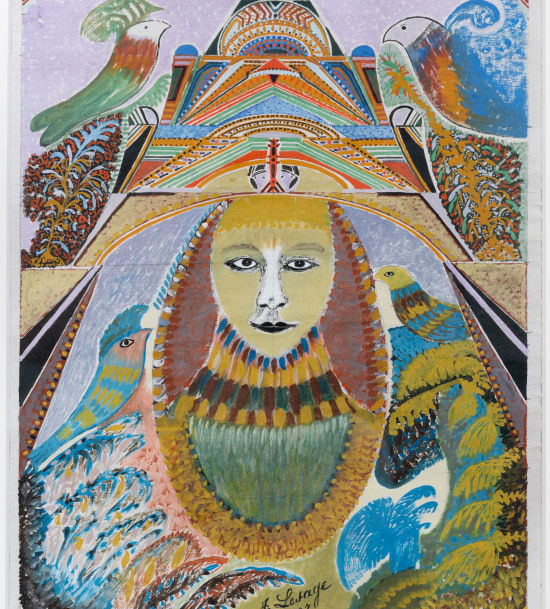read only - no display
read only - no display

Adolf Wölfli, Bangali Firework (Bänggaalisches Feuerwärk), 1926, Colored pencil on paper, 18.5 x 24.5 inches (47 x 62.2 cm)
Although the roots of Outsider Art can be traced back thousands of years, it is most useful to look back to its most recent precursor, art brut (Raw Art) to hear the most vital articulations of its true spirit. In his 1947 manifesto, French artist and curator Jean Dubuffet described the term art brut as follows: "We understand by this term works produced by persons unscathed by artistic culture, where mimicry plays little or no part (contrary to the activities of intellectuals). These artists derive everything...from their own depths, and not from the conventions of classical or fashionable art."
In his 1972 book championing art brut, Roger Cardinal called it Outsider Art: "I believe that a paramount factor in the critical definition of the creative Outsider is that he or she should be possessed of an expressive impulse and should then externalize that impulse in an unmonitored way which defies conventional art-historical contextualization."
Dubuffet and Cardinal were writing primarily about extremely marginalized European artists: psychotics, mediums, and eccentrics. This has caused the common misconception that Outsider Art is essentially pathological, when in fact the central characteristic shared by Outsiders is simply their lack of conditioning by art history or art world trends.
Over the years, the parameters of Outsider Art have expanded dramatically to include art made by a wide variety of art-makers who share this common denominator of raw creativity. Outsiders come from all walks of life, from all cultures, from all age groups.
In recent years, Outsider Artists may have even come to outnumber Insider Artists who have achieved critical validation within the elite art world, and yet who speak with increasingly less clarity and relevance to us about the human experience. Dubuffet's description of officially recognized art has never been more relevant: "everyone immediately sprinkles it with champagne, and lecturers lead it from town to town with a ring through its nose. This is the false Monsieur Art."

Martín Ramírez, Untitled (Super Chief), 1954
Pencil and crayon on paper, 55 x 51 inches (139.7 x 129.5 cm
The genesis of Outsider Art could well be traced to an imagined prehistoric cave wall, to the work of your favorite eccentric visionary (think William Blake), or to the mythic artist-genius dreamed up by Romantic philosophers and poets. Outsider Artists began to emerge as a force to be reckoned with during the early 1920's, with the publication of two pioneering studies of art made on asylum inmates, conducted by European psychiatrists in search of universal truths about human creativity.
German Expressionists soon fell in love with the schizophrenic artists presented in these books--especially Adolf Wölfli, Karl Brendel and August Naterrer--and adopted them as creative muses by appropriating their imagery. In Paris, the Surrealists looked to the same books for inspiration, and also to Spiritualist Mediums such as Augustin Lesage and Helene Smith who were famous local practitioners of automatic drawing.
It wasn't until after World War II that Outsider Art was truly recognized as more than simply source material for the modernist avant-garde. The French artist Jean Dubuffet took the Surrealist obsession with Outsiders to a new level by daring to collect and exhibit their work. Not only did he champion the artwork of schizophrenics and local mediums, but he also celebrated art made by eccentric isolates and self-taught laborers. Dubuffet recognized in the work of these divergent groups one unifying trait: a raw quality untouched by academic rules or current trends.
In 1947, Dubuffet staged a ground-breaking, manifesto-driven exhibition in Paris, aptly naming his category art brut (Raw Art). Dubuffet's Collection de l'Art Brut grew in the subsequent decades, and eventually found a home in Lausanne, Switzerland, in 1976. This unique collection might well have remained in isolation, if not for the publication of a 1972 study of art brut entitled Outsider Art written by the British scholar Roger Cardinal. Cardinal's book, and his 1979 London exhibition Outsiders, launched Outsider Art as a powerful global force that continues to challenge and redefine the limits of what we call art.
The critical definition of the creative Outsider is that he or she should be possessed of an expressive impulse and should then externalize that impulse in an unmonitored way which defies conventional art-historical contextualization.
- Roger Cardinal

Judith Scott, Untitled, 2003, Mixed media, 20 x 16 x 10 inches (50.8 x 40.6 x 25.4 cm), Courtesy of Creative Growth Art Center

Augustin Lesage, Untitled, 1927, oil on canvas, 47x37cm.
Dubuffet did not permit his Collection de l'Art Brut to circulate after its permanent installation in Lausanne, in 1976. While previous exhibitions like Harald Szeemann's 1972 edition of Documenta brought wider attention to the radical category of art brut in Europe, it was the 1979 Outsiders exhibition at London's Hayward Gallery that launched it internationally. Co-curators Roger Cardinal and Victor Musgrave expanded Dubuffet's original vision to include American artists such as Henry Darger, Martin Ramirez and Joseph Yoakum, opening the door to artists influenced by vernacular culture, a trait Dubuffet had previously rejected. What had started as a focused challenge to the rigid limits of the mid-20th century Paris art world was now emerging as an international phenomenon poised to unify a vast range of marginal art under the banner of Outsider Art.
By the early 1980s, Outsider Art began to radically transform the field of American Folk Art. Curators, collectors, scholars, and critics who had been struggling unsuccessfully to fit contemporary marginalized artists into the traditional category of Folk Art began to adopt the revolutionary spirit of Outsider Art. Collectors and curators began to make bold, contradictory acquisitions and new, risky curatorial moves that presented American and European artists side by side. The spark of Outsider Art illuminated Folk Art exhibitions throughout the 1980s, including the Corcoran Gallery's seminal Black Folk Art in America:1930-1980, Muffled Voices: Folk Artists in Contemporary Art at the Paine Webber Art Gallery in New York and Baking in the Sun: Visionary Images from the South at the University of Southwest Louisiana.
These and other exhibitions forced a radical split between the traditional and the contemporary aspects of this field. Contemporary Folk Art became synonymous with Outsider Art, despite scholarly rejections on grounds of political incorrectness.
By the early 1990s, Outsider Art was poised to challenge the arbitrary boundaries of the art world. LACMA’s 1992 exhibition “Parallel Visions: Modern Artists and Outsider Art” demonstrated the powerful influence Outsiders had exerted on the mainstream, from the early 20th century on. A more recent reprise of this show, “Outliers and American Vanguard Art,” (2018-19) was hosted by the National Gallery of Art, Washington DC. In the last two decades, curators with an experimental bent have played a major role in staging hybrid shows, including “After Nature,” at the New Museum (2008), “Dargerism” at the American Folk Art Museum (2008), and “Glossolalia" at MoMA (2008) Such shows combined the work of Outsider and Insider Artists, questioning the constructs of mainstream and margin.
The most profound development in the recent history of Outsider Art has been the global emergence of art fairs and events dedicated to the work of Outsiders, such as the Outsider Art Fairs in New York and Paris. Another key development is the increasing inclusion of Outsiders in long-established international exhibitions, such as Documenta, the Carnegie International, and the groundbreaking Venice Biennale #55 (2013), named “The Encyclopedic Palace” by curator Massimiliano Gioni to honor the vision of Italian-American Outsider artist Marino Auriti. Other institutions that have embraced Outsider artists include The Brooklyn Museum with its 2014 Judith Scott retrospective, “Bound and Unbound,” The Museum of Modern Art, City of Paris, with the 2015 solo exhibition “Henry Darger,” and The Metropolitan Museum of Art, New York, with its 2018 exhibition “History Refused to Die.”
American Folk Art Museum's exhibition "Paa Joe: Gates of No Return" featured in Time Out New York.
On November 18, LACMA Los Angeles County Museum of Art will open the third leg of "Outliers and American Vanguard."
Jerry Saltz remembers Phyllis Kind in his obituary on Vulture
After over 180 irreverent exhibitions, a beloved Paris gallery prepares to close its doors.